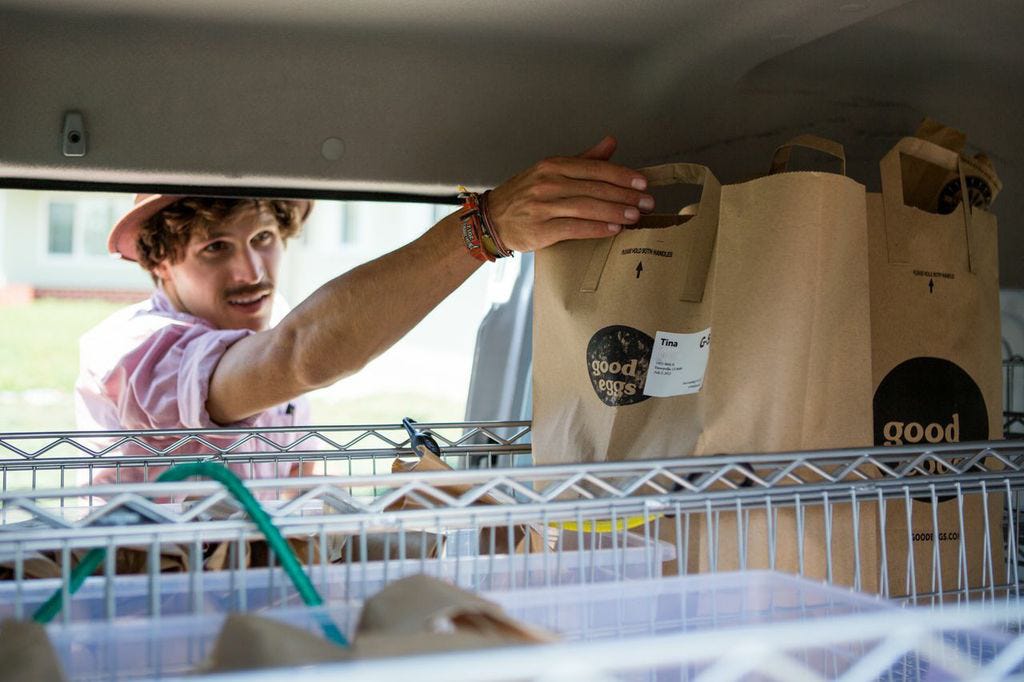
It might be easier to get trendy cocktails in the Tenderloin these days, but you’d still be hard pressed to buy a fresh bunch of kale. Living in the city’s only neighborhood without a full-service grocery store, Tenderloin residents are either schlepping groceries across the city or scraping together meals from the frozen peas, aging bananas, and canned beans found in corner stores. More than 40 dedicated grocery stores to date have refused to set up shop in the neighborhood. So it’s a pleasant surprise to see local food startup Good Eggs starting a pilot program to bring food delivery to the Tenderloin.
Through a partnership with non-profit housing provider Tenderloin Neighborhood Development Corporation (TNDC), Good Eggs launched services on Sept 2, 2014 through a kiosk in one of TNDC’s buildings near Civic Center. The program is specifically intended to be affordable for limited food budgets: for every $10 ordered, TNDC residents get an additional $20 credit. Participating residents then get local, high-quality food delivered right to their door, the exact same food and service that’s becoming increasingly beloved by smartphone-wielding families in Noe Valley or Glen Park.
It’s a significant victory for those who believe that the tech revolution can improve the lives of all San Franciscans, regardless of income. And while the program faces serious challenges — providing services for residents without credit cards, internet access, or cell phones, for example — it’s a promising oasis in the midst of one of San Francisco’s most notorious food deserts.
“Technically, the area isn’t a food desert,” TNDC’s Chief Operating Officer Liz Orlin corrects. “It’s really more of a food swamp. Food is in reach; it’s quality and cost that is the issue. It’s not fresh foods and vegetables, it’s lots of processed and sugary foods or alcohol. What we’re trying for is greater variety, better quality, and freshness.”
Both city officials and local groups, like TNDC, have spent decades trying to find ways to bring into the Tenderloin the type of healthy, local food that most San Francisco residents take for granted. TNDC and city officials have worked hard to secure a brick-and-mortar grocery store with no luck. But they’re not waiting on others to provide solutions. TNDC has created community gardens in several of its buildings and has established a list of offerings at smaller shops that help locals find healthier options. Acknowledging that not everyone wants to cook every night, TNDC is working on helping open a neighborhood healthy food restaurant that will provide regular service along with a certain number of highly subsidized meals for locals. For those that do want to cook, TNDC has worked with local group Leah’s Pantry to publish a community cookbook to circulate easy, healthy recipes that are doable without a stove.
But with all these efforts, TNDC’s research found that Tenderloin residents were still spending half their food budgets outside the neighborhood, schlepping the food back by MUNI, bicycle or on foot.

Good Eggs in the meantime has been searching for ways to integrate lower income communities into their model. After stabilizing their core business model and expanding to four cities, Good Eggs’ Food Access and Community Development Rahmin Sarabi started looking for collaborative relationships with local groups in each area.
Their intention with these relationships are to make fresh, local food accessible for lower income communities. “We’re not sure what the solution looks like,” said Sarabi. “Our whole posture is to keep trying things until we find out what actually works. We want to design and meet people where they’re at.”
Both Orlin and Sarabi stressed that the project is in early days. The first site is in a single resident occupancy (SRO) building mainly housing formerly homeless men without families — so far, not a single resident has yet signed up for the pilot. With average monthly grocery budgets of $100/month, it’s possible that even with the subsidies, Good Eggs food will remain too expensive for Tenderloin residents to afford on a regular basis. And it’s not clear how long the subsidy funding, provided by venture capital fund Index Ventures and the Philanthropic Ventures Foundation, will last. But both TNDC and Good Eggs are encouraged by the partnership’s potential and are planning to try two new sites in buildings full of families — Good Eggs’ core demographic.
“It’s exciting to partner to create something new that both TNDC and Good Eggs value,” Orlin offered. “Our interests on this feel aligned and there’s excitement in being in uncharted territory. The energy Good Eggs is bringing for trying stuff out, even before we know if it’s going to work, has been energizing and educational for us. The realities of what we face have been educational for them. It feels truly like a partnership.”
Photos via Thinkstock and Good Eggs







